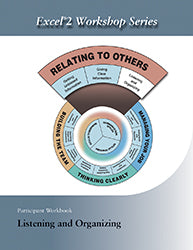HRD Press
Listening and Organizing Workshop
Listening and Organizing Workshop
Couldn't load pickup availability
The Rationale
Within the past few decades we have moved from an industrial age to an information age. One of the major functions of employees at all levels (from mailroom to boardroom) is to process information. Although much of this information is printed as hard copy (ink) or soft copy (CRT), most managers get the majority of their information via the spoken word. And this means listening.
This workshop addresses the 2 types of listening we must practice: active and passive. Most of our listening at work is active¼ we can interact with the speaker, asking questions, summarizing, restating, clarifying, giving confirming feedback, and so on. But sometimes we cannot interact (e.g., with a radio or TV presentation, in a meeting where we are silent observer). Here our role is more passive, although our mind may be every bit as active as when we can interact with the speaker.
Learning Objectives for the Workshop
Participants who attend this workshop will be able to:
- Identify 6 guidelines to listening analytically
- Distinguish between fact and opinion
- Illustrate listening barriers with examples: emotional, semantic, physical
- Convert loaded statements to their neutral equivalents
- Use the communication model to show sources of distortion of meaning
- Assess their comprehension and retention on a 100-point scale
- Describe 8 things speakers can do to help their listeners
Performance Criteria in the Workplace
Participants who attend this workshop will be able to:
- Listen for intent (action, purpose) as well as content
- Give the speaker feedback (questions, summaries) to confirm understanding
- Evaluate messages by filtering out bias (opinion, emotion, etc.)
- Organize complex messages for retention
- Recognize gaps, omissions, inconsistencies, etc., and work for closure
- Eliminate barriers relating to source, medium, and destination
- Apply the 6 guidelines of effective listening
Share

